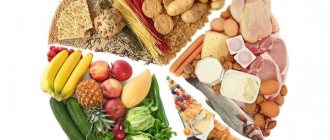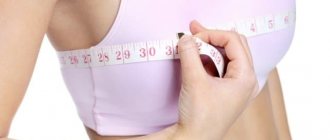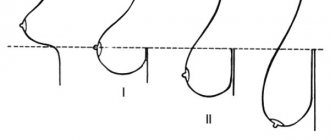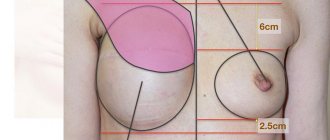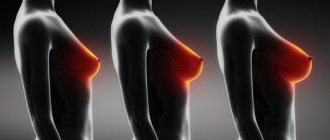Mammary glands are organs that are found in both men and women. They consist of glandular and adipose tissue. Their size is strictly individual. In men, as a rule, breasts do not reach large sizes, this is due to their functional uselessness.
For a woman, this organ is very important.
This is due to the fact that it performs several functions at once:
- First of all, this is the function of lactation. After the birth of a child, the process of functioning of the glandular tissue and the filling of the ducts with milk occurs in the glandular tissue. A woman can use this organ to carry out full feeding.
- This is an aesthetic function. And one of the functions is erotic. In sexual terms, the breast performs the function of arousal and the development of orgasm; this is largely created thanks to the glandular component, which is well supplied with blood and has a high degree of innervation.
Stages of breast development
From birth to 10 years
The initial stages of breast formation begin at the stage of organ formation.
In this case, on the chest there are only rudiments of glandular tissue with disorganized ducts.
There are nipples on the skin, but they do not have such a rich blood supply and innervation as in the future.
But it should be noted that at this time the mammary gland is already sensitive to hormones.
Immediately after birth, during the first days, the mother may notice an increase in breast size in the girl, a clearly defined milk line and discharge from the nipples.
This is due to the entry of estrogen into the girls’ bodies from the mother’s body. This condition does not require any treatment. After a certain time, the condition passes. Nipples may be slightly rough at this time. The milk line in girls remains slightly visible, while in boys it is not.
Initial stages of mammary gland maturation 12-13 years
This condition begins at the age of 10 years.
The girl begins to notice the maturation of her body, which is not yet very noticeable. From a structural point of view, the formation of the mammary glands begins, and a clearer formation of the milk line occurs.
The nipple swells slightly and rises above the surface of the skin.
There may be an increase in temperature above the surface of the nipple, some girls feel pain above the surface.
There is no increase in the gland tissue itself. The areola color may be darker than before. If you begin to palpate the breast, you can feel a small compaction that resembles a ball that moves under the skin. This formation is glandular tissue, and it is not painful during this period. This time is considered the beginning of puberty and is characterized by the appearance of other sexual characteristics.
Puberty period
This is one of the important periods in the life of a girl and subsequently a woman.
On the part of the mammary glands, the process of active breast growth is underway. The process of development of glandular tissue and its increase in size is underway. This will be the most active tissue growth in the life of the female body.
There is also a change in the shape of the nipple, and a smoothing of its shape is observed. At this time, as a rule, the onset of menstruation occurs.
This is very important for the functioning of breast tissue. And at the same time, before the next onset of menstruation, the breasts increase slightly, become more sensitive, and in some girls it will be painful.
The process of completing breast development
During this period, slight breast growth continues.
But it will not be as noticeable as before. The breast size that is formed by a given age will remain the same until pregnancy and childbirth.
This moment will be very important, especially until the moment of feeding the born baby.
The formation of the milk ducts has been going on for some time.
It is during this period that breast growth ends and further changes can only occur during the period of exposure to progesterone in a pregnant woman.
Outwardly, it is no longer different from the breasts of an adult woman. Its size may vary and will depend on many factors. Normally, pre-existing denser areas will soften. There is also more intense pigmentation of the breasts.
Due to the thinning of the surface tissue, blood vessels become translucent. At this point, in some cases there may be increased sensitivity.
What size should breasts be at 12 years old?
At the age of 10-11, most girls begin the process of breast growth. By the age of 12, the mammary glands include underdeveloped glandular tissue, which is in the active growth phase. Due to the tightness of the skin in the chest area, the mammary glands remain elastic and compacted. Limited space leads to the formation of an equally convex organ shape in all adolescents.
In obese children, the mammary glands may acquire an elongated shape in the horizontal plane, which may initially form a connective tissue membrane of irregular configuration. Because of this, adult breasts may not form the shape that a woman would like to have.
Question to the expert
Doctor, can you give me advice on how to grow breasts at 12 years old? I really want to have a beautiful bust!
There are no natural ways to quickly enlarge the mammary glands. It is important to eat right, never start sexual activity early, and lead a physically active lifestyle.
When do breasts start to grow?
The process of onset of growth begins approximately from the moment of the onset of puberty; it will differ for different girls, due to the peculiarities of the constitution.
On average, this period starts from 12 years and ends approximately 3-4 years after the start of menstruation.
Serious morphofunctional changes occur in the girls’ bodies, and secondary sexual characteristics begin to appear:
The appearance of hair growth in the pubic area and armpits. At the beginning, these are single thin hairs, which gradually become denser and darker.- Changing the shape of the hips and buttocks. They begin to enlarge and take on feminine shapes.
- Characteristic sweating is noted. Sweat begins to be released during physical exertion or increased excitement, and its smell changes.
- The appearance of menstrual flow.
What affects breast growth?
Hormones
The female breast is a hormonally dependent organ.
Its growth and development depend largely on their content in the body. The process of breast development depends on estrogen. This influence is dominant during puberty.
Subsequently, the breasts begin to grow to a lesser extent.
Estrogens promote the development of glandular tissue in the mammary gland.
It is she who contributes to the formation of the foundation in the breast tissue. Even in the absence of accumulation of adipose tissue, the glandular tissue will form the bulk.
The effect of estrogen on breast growth has a significant impact in many ways during lactation. The amount of milk will depend on the amount of the ferrous component. The hormone progesterone also affects breast growth.
It promotes cellular differentiation of tissues. Thanks to progesterone during pregnancy, the final formation of the gland occurs with the development of the milk ducts. They promote the subsequent release of milk.
These hormones are inextricably linked during breast growth; estrogens and progesterone help protect against the effects of other factors. To a lesser extent, prolactin influences breast growth and development. This hormone acts indirectly on tissue and increases the secretion of milk by the gland.
At the same time, it seems to the woman that her breasts have grown. In fact, the milk ducts, which are normally in a poured state, are filled with milk, and thereby increase the volume of the tissue. As soon as a woman stops breastfeeding, prolactin decreases and breast size decreases.
Nutrition
Nutrition should be given great importance in breast growth. Food products that contain not only vitamins and minerals, but also fatty acids necessary for the full growth and differentiation of gland tissue.
A woman who cares about her health should pay great attention to nutrition. For the growth and full development of the breast, a large amount of fatty acids is required, mainly from the group of polyunsaturated ones.
These are vitamins involved in the synthesis of hormones. Among the foods that affect breast growth are nuts. Not only are they high in healthy fats, but they also contain the right amount of fat and protein while being relatively low in carbohydrates. Calorie intake will also affect the production of estrogen in tissues.
To a greater extent, such nuts are walnuts, cashews, and pine. According to the misconception of many women, peanuts are not healthy enough for the female body. This is due to its high calorie content and low nutritional content.
Products containing phytoestrogens. They are an alternative and healthy replacement for the natural hormones of the female body.
It is phytoestrogens that will promote the growth of the glandular component of breast tissue, as well as an increase in the content of the fat component. There is no complete replacement of natural hormones, but a sufficient amount of them is replenished in case of deficiency.
Foods that promote breast growth include:
- Legumes. These products are most useful when boiled. In this case, it is recommended to prepare puree or cook separately. Soy can also be considered, but only that which is consumed in its pure form, and not mixed with additional food additives.
- Flaxseed oil and seeds . These are very useful products for both the male and female body. This is achieved due to the effect on the breasts contained in saturated fatty acids and phytoestrogens, as well as beneficial vitamins and minerals that contribute to the full growth and maintenance of the breast at the proper level.
- Various green fruits and vegetables, such as spinach, sorrel, etc. Some doctors recommend eating bananas; they contribute to the deposition of fatty layers in the buttocks and chest.
Physical exercise
This method, which is used for breast growth, is considered controversial.
This is due to the fact that usually a woman begins to exercise in order to lose extra pounds, and therefore fat tissue is also lost.
As a result of such interventions, on the contrary, a decrease in breast volume occurs, instead of growth, regression is observed.
And in order to achieve breast enlargement, a woman needs to use certain types of exercises and at the same time monitor her diet.
Nutrition should be nutritious, this is due to the fact that a lack of calories leads to the burning of adipose tissue, including in the mammary gland.
After physical activity, breasts grow only with an increase in muscle mass; it is for this purpose that weightlifting or bodybuilding methods are used.
A similar picture is created due to the build-up of the pectoral muscles, especially the pectoralis major. Such procedures can slightly increase breast size, but at the same time the figure acquires a masculine outline.
The method of physical exercise does not help to dramatically increase breast size, but it can help:
- Physical strength exercises only lead to building up the muscles located under the fat and glandular tissue.
- They also restore and support the fascia on which the breasts are located.
- Moreover, after performing a set of exercises for a long time, a woman may notice only a slight change in shape and fit, but there is no effect on the state of the structure of the main mass of the breast.
Heredity
Many women are interested in the issue of heredity at the stage of breast formation. Such factors play a partial role in the formation of an organ.
As a rule, there is a pattern: if a woman has large breasts, then her daughter’s breasts are quite large. Genetic factors play a large role in the transmission of this factor along the maternal line.
On the father's side, such characteristics are transmitted less frequently. The exact relationship has not been established, but there are guesses about the characteristics of the formation of the amount of adipose and glandular tissue.
In women who have a fairly low weight and at the same time large breasts, there is a possibility that a large amount of glandular tissue is initially being laid down.
Other factors
As it turned out, quite a lot of factors influencing the growth and development of the mammary gland have been identified. These also include body features and increased body weight. Since the mammary gland has several main tissues in its composition, it is due to adipose tissue that it will grow with an increase in body weight.
This factor is the most vulnerable, because even minor fluctuations in weight affect the breasts, reducing their size. Women who are prone to rapid changes in body weight are more likely than others to experience problems such as stretch marks and sagging due to insufficient skin elasticity.
Body type
Factors such as body type also influence the size of the mammary glands. It is with this that the deposition of subcutaneous fat is associated.
Among them there are three types:
- The first is an hourglass , in which there is a fairly uniform distribution and such a woman is quite large in size.
- But “pears” have the peculiarity of deposition of adipose tissue in the hip area, which means their breast growth is limited and large sizes, as a rule, are not found.
- Women with broad shoulders can have different sizes; if this is an athletic type, then the breasts are small, and when fatty tissue is deposited in women in the upper part of the body, on the contrary, it leads to large breast growth.
Taking hormonal drugs
It is also one of the factors for breast growth. It is connected with the fact that there is a supply of hormones necessary for the reproductive system, mainly estrogens and gestagens; in addition to affecting the female genital organs, they also affect the breasts, which are also hormonally dependent.
In some cases, when there are signs of insufficient maturation of the mammary glands, they help complete this process, especially under the influence of the gestagen component.
Due to estrogen, there is also a fairly active maturation of mammary gland tissue, but in this case, adipose tissue is deposited in the breast. Such substances include combined oral contraceptives.
Among them are the following:
- Jess,
- Yarina,
- Median,
- Regulon and others.
Regulon Jes Midiana Yarina
Why do breasts grow slowly?
Slow breast enlargement is rarely caused by diseases or factors that a girl can influence. The growth rate of glandular and adipose tissue depends mainly on the level of estradiol and progesterone in the blood. They determine the intensity of the formation of new mammary ducts and the proliferation of their cells.
Estrogen levels, in turn, can decrease due to the following factors:
- Improper functioning of the pituitary gland.
- Thyroid diseases.
- Poor nutrition.
- Stressful situations.
- Lack of physical activity.
- Inflammation of the ovaries.
- Hormonal disorders after abortion.
- Taking hormonal drugs.
With small breast volumes in mothers and grandmothers, you should not hope for a size 3 daughter with a normal weight, because genetics plays an important role in the development of secondary sexual characteristics. If your breasts are not growing, then you can ask what foods you should eat to stimulate their growth.
If slow breast development greatly worries a girl, then you can consult a doctor to rule out serious pathologies that may limit the development of breast tissue. Self-administration of hormonal drugs before the age of 18 to accelerate breast growth is unacceptable, as it can lead to permanent disorders of the endocrine system.
Question to the expert
Please tell me what breasts should be like at 11 years old? My daughter will have almost no breasts when she grows up?
The absence of pronounced breasts in an 11-year-old girl is a variant of the norm. Wait a little and it will definitely grow.
What to do when breasts stop growing?
Some girls face such a problem that their breasts either do not begin to grow at all or their development stops quite quickly. This condition may be not only a constitutional feature, but also a sign of pathological changes.
First of all, the most basic problem may be disrupted hormonal levels. This condition requires mandatory diagnosis and early treatment. Subsequently, such a pathology can lead to impaired fertilization and possible pregnancy.
To solve the problem of the end of breast growth, you should consult a specialist. An endocrinologist with the help of a gynecologist deals with the issue of hormonal disorders that lead to the end of breast growth.
It is very difficult to restore breast growth without medication. As a rule, only hormonal treatment, which includes estrogens and progesterone, helps to restore breast growth after stopping.
Prolactin does not affect the growth of the mammary gland; if it is prescribed, false lactation may occur.
The cessation of breast growth before the age of 14, subject to timely sexual development, is considered pathological.
Breast swelling - signs
An enlarged mammary gland does not necessarily signal illness. In parallel with the swelling, a new symptom develops that causes inconvenience - contact a specialist:
- the pain does not go away even if the woman lies or sits;
- physical activity is impossible;
- fluid from the milk ducts;
- breasts have enlarged.
Headaches, abdominal cramps, loss of activity, and general deterioration in health may also indicate illness.
How to help breast growth?
Proper nutrition is of great importance.
During this period, it is especially important for a girl to monitor her diet. A nutritious and balanced diet does not lead to breast growth, but at the same time it contributes to its full formation. To do this, you should consume a sufficient amount of foods containing phytoestrogens:
- Spinach, legumes, pumpkin, etc.
- They also include foods with sufficient vitamins and fatty acids, such as fruits and nuts.
- In addition, during the growth of the body, a large amount of protein must be supplied, which is necessary for the full development of organs, including the structures of the mammary glands.
- Among physical activities, exercises aimed at strengthening the muscles of the chest and spine, as well as maintaining fascia, will be useful. These include exercises with a skipping rope, push-ups and swimming.
Pathological causes
Severe discomfort, noticeable breast enlargement is a signal from the body about the development of diseases:
- Mastopathy - manifests itself both during menopause and at any age. Signs - after the next menstruation, the breasts become full, sore, and there is a feeling of heaviness. The diagnosis can be cystic, fibrous, diffuse or focal mastopathy.
- Fibroadenoma (during pregnancy). It is associated with the appearance of benign tumors. Causes pain and swelling of the glands. The pathology cannot be treated during pregnancy, since medications cannot be taken.
- Oncology - a disease of a malignant or benign nature causes breast swelling.
It does not matter whether the swelling of the glands is caused by physiology or pathology. You should not ignore the symptoms, but consult a doctor for a correct diagnosis.
When should you start wearing a bra?
It should be understood that the point of using a bra is to properly support the breasts, so that fragile and unusual ligaments do not stretch and there is no increased load on the fascia with a subsequent reduction in sagging.
As soon as the processes of increasing glandular tissue and breast swelling begin, it is necessary to choose the right underwear.
The first bra should be comfortable, without underwires or tight elastic bands. It is preferable to use them from natural fabrics, mainly cotton.
In this case, the decorative element is not important; there is no aesthetic formation of the breast yet. Correct selection of a bra is important so that at the formation stage there is no disruption of lymphatic drainage and blood supply.
If such processes occur in the tissue, this can lead not only to growth disturbances, but also to the development of pathological space-occupying formations.
We identify the reason
There were no injuries, but pain and swelling are observed? Take advantage of medical advances - all possible diagnostic methods are at your service. They will allow you to identify pathologies in the early stages:
- Palpation of the chest.
- Ultrasound of the adrenal cortex.
- Mammography.
- Enzyme immunoassays.
- MRI and CT of the adrenal glands and brain.
- Ultrasound of the glands and thyroid gland.
- Blood test for hormone levels.
- Urine testing for nitrogen.
- Examination of the pelvic organs.
The doctor will prescribe diagnostic procedures.
What not to do?
A few tips on what not to do:
- One of the most erroneous misconceptions women have about their mammary glands is the use of hormonal drugs to increase their size and growth. Along with changes in the tissues of the glands, adipose tissue is deposited in various parts of the body.
- Wearing clothes that don't fit properly can cause your breasts to stop growing. This is especially true for smaller bra sizes.
- The use of various physical methods that can injure immature breast tissue.
